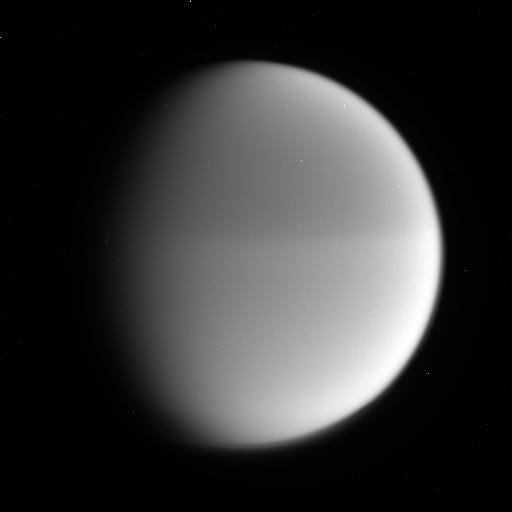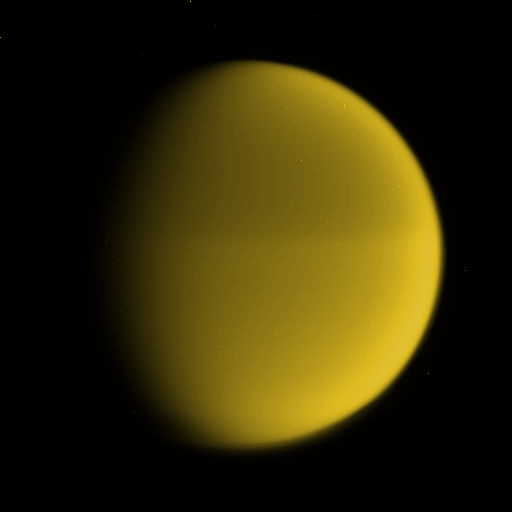January 7, 2020 : A New Research Work Involving Takahiro Iino Reveals
That ALMA Has Measured The 14N/15N Isotopic Ratio In CH3CN Of The Opaque
Atmosphere Of Titan
A new research work proposed on January 7, 2020 by a team of researchers composed of Takahiro Iino, Hideo Sagawa and Takashi Tsukagoshi and presented in Arxiv reveals the measurement of the 14N/15N isotopic ratio in CH3CN in the atmosphere of Saturn's largest moon Titan via ALMA. The planetologists were in a position to detect submillimeter rotational transitions of CH3C15N found at the 338 GHz band in the spectra of Titan's opaque atmosphere thanks to the analysis of archival data collected by the Atacama Large Millimeter/submillimeter Array (ALMA). A comparison between those observations and the simultaneously observed CH3CN lines at the 349 GHz band, which allow us to study the area from the altitude of 160 km to the altitude of about 400 km, allowed the researchers to deduce the value of the ratio 14N/15N in CH3CN at about 125. The level of accuracy remains limited but it allows the scientists to advance that the value of 14N/15N for CH3CN is higher than the values that have been previously determined and theoretically predicted for HCN and HC3N. The difference may be related to the different N2 dissociation factors whose impact depends on the altitude as proposed by a recent photochemical model.
The isotopic ratio between 14N and 15N can vary in the various nitriles present in Titan's atmosphere. The differences are closely related to the production processes of the molecules. The dissociation processes of N2 can be generated via the action of ultraviolet light from the Sun, via the action of magnetospheric electrons or via the action of galactic cosmic rays. Regarding the nitrile CH3CN, a photochemical model predicted a value of 120-130 in the lower part of the stratosphere for the isotopic ratio 14N/15N. The expected value is much higher than that for the nitriles HCN and HC3N which is, approximately, between 67 and 94. The value of 125 for the ratio 14N/15N in the molecule CH3CN which was measured by ALMA appears clearly higher than the value measured and predicted for the ratio 14N/15N in the molecules HCN and HC3N. The dissociation factors which depend on the altitude must be considered. Researchers are particularly interested in the chemistry of Titan's complex atmosphere which represents, to a certain extent, a soup of various molecules, elements or ions and which may resemble the atmosphere of the Early Earth.
Titan is an exceptional world due to its thick and opaque atmosphere which can be compared to the atmosphere of Venus for instance. The largest moon in the Solar System, Ganymede, is devoid of any significant atmosphere but the second largest moon in the Solar System, Titan, which evolves farther from the Sun, contains a deep, thick or dense atmosphere. Most moons are devoid of any atmosphere because they are too light or not heavy enough to retain any significant atmosphere. The Moon, for instance, has a dark sky because the celestial body is devoid of any atmosphere. Mars has a thin atmosphere and researchers are particularly interested in its dynamics in the long run. Will the atmospheric pressure on the surface progressively decrease over geologic time scales ? Will its composition change ? The study of the atmosphere of other worlds can tell us a lot or bring significant clues regarding the potential evolution of our own atmosphere. The Terrestrial or icy worlds of our Solar System containing an atmosphere are not numerous. Venus, the Earth, Mars, Titan, Triton and Pluto are the known worlds which contain an atmosphere today.
Each atmosphere has its particularities. The atmosphere of Saturn's largest moon Titan looks like the atmosphere of Venus in terms of appearance but its composition is relatively close to the composition of our atmosphere. Titan, which appears opaque from outer space and which is quite uniform in the visible spectrum like Venus, contains an atmosphere which is dominated by molecular nitrogen like the atmosphere of the Earth. However, oxygen is absent or almost absent in Titan's atmosphere and water can only appear in its solid form on Titan's surface or in Titan's atmosphere. Oxygen is the second most abundant compound of our atmosphere whereas methane is the second most abundant compound of Titan's atmosphere. Methane which is composed of carbon and hydrogen and which is the simplest hydrocarbon molecule can be found as a gas on Earth. But in the harsh environment of Titan, where temperatures evolve around minus 179 degrees Celsius, minus 290 degrees Fahrenheit or 94 Kelvin, methane can appear in its liquid form. Therefore, a parallel can be drawn between water on Earth and methane on Titan.
During the Cassini-Huygens mission in the Saturn System, from 2004 to 2017, we have been in a position to study the dynamics and the composition of Titan's atmosphere. We have clearly seen that various types of clouds can form above Titan's surface. Cyclones can develop in the polar areas and dynamic clouds can take shape at low or mid-latitudes from time to time. The clouds can be composed of methane or ethane. Like on Earth, there are evaporation processes, condensation processes and precipitation processes on the Opaque Moon. But the key molecule of the meteorological cycle of Titan is methane instead of water. Methane (CH4) and ethane (C2H6) can engender lakes, seas or rivers on Titan. Thus, the Earth and Titan look alike to a certain extent. Yet, some landscapes of Titan may appear particularly exotic because molecules like methane or ethane have different properties from water. Methane and ethane can interact with molecular nitrogen in the pools of liquids and engender exotic phenomena. For instance, bubbles of nitrogen may suddenly appear and go up in the lakes or seas of Titan.
Planetologists are particularly interested in the dynamics and in the chemistry of hydrocarbons and organics of Saturn's largest moon because they are likely to tell us a lot regarding the chemistry of organics or regarding life on Earth. Researchers try to determine why there is a relatively significant concentration of methane in Titan's atmosphere because methane is supposed to progressively disappear over time under the action of radiations from the Sun and in particular UV light from our star. In the upper atmosphere of Titan, complex chemical interactions occur under the action of ultraviolet light from the Sun. The upper atmosphere of the giant moon of Saturn represents a soup of molecules, ions or particles which interact to form new molecules like methane, ethane, acetylene, ethylene, radicals or organics. The heavier molecules tend to go down. The haze of Saturn's largest moon is the outcome of complex chemical interactions involving hydrocarbons, organics and radiations from the Sun. The linear and parallel dunes found at low or mid-latitudes in the relatively dark areas may be rich in tholins or organics.
Tholins may be widespread in the Outer Solar System and in particular on Titan where there are regular or constant interactions between the atmosphere and the crust or the pools of liquids. Tholins have been found, for instance, on the surface of Pluto, the largest known Dwarf Planet. A type of red or dark mud tends to take shape on the surface of celestial bodies found in the Outer Solar System. That's the case for Arrokoth or 2014 MU69 for instance. The panoramic views of Titan's surface acquired from the Huygens probe during its atmospheric descent on January 14, 2005 had clearly shown a dark or red plain contrasting with bright hills. That dark or red plain may be composed of a mud or sludge rich in tholins and methane. The Huygens probe had recorded a relatively strong release of methane during the landing process. Planetologists try to imagine or to determine the potential interactions between the underground, the soil and the atmosphere of the Hazy Moon. Snowfall of organics or hydrocarbons may be encountered from time to time. But the appearance of the Titanian snow may be completely different from the typical snow we can find on Earth. The snow of the Earth is white whereas the snow of Titan may be red or dark.
Most moons of Saturn appear bright and relatively uniform. That's the case for Mimas, Enceladus, Tethys, Dione or Rhea. Those worlds are rich in water ice. The infrared or near-infrared views of Titan have clearly shown that the surface of Titan is much more diverse than the other worlds orbiting Saturn. There are canyons, fractures, hills, mountains, geologically young areas, a particularly limited amount of impact craters, rivers, lakes and seas. Planetologists are wondering whether there are geysers or active cryovolcanoes on Titan today. Some bright surface features or some circular features may correspond to potential cryovolcanoes. However, we have not clearly identified clear signs of cryovolcanic activity today. Cryovolcanoes or geysers may fuel the deep and thick atmosphere of Titan and may explain its remarkable weight. Pluto, Triton or Enceladus contain geysers or cryovolcanoes. So, why not Titan ? The elements, the molecules, the gases or the liquids spewed by the hypothetical cryovolcanoes or geysers may tell us a lot regarding the internal structure of Saturn's largest moon which may contain a subsurface ocean dominated by liquid water or dominated by liquid hydrocarbons like methane, ethane or propane.
|
The image in the upper part of the table reveals a raw image of Titan's disk obtained from the Cassini spacecraft on December 14, 2009. The image whose file name is N00148433.jpg was acquired using the CL1 filter and the MT3 filter. The view had not been validated or calibrated. A validated or calibrated view was going to be archived with the Planetary Data System proposed by NASA. The image in the lower part of the table represents a colorized version of the raw image. Credit for the raw image: NASA/JPL-Caltech/Space Science Institute. Credit for the colorization of the raw image: Marc Lafferre, 2020. |
- To get further information on that news, go to: https://arxiv.org/abs/2001.01484.

